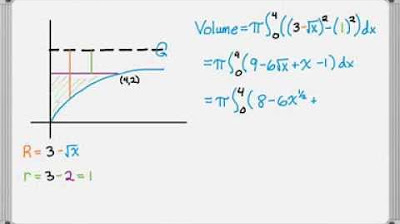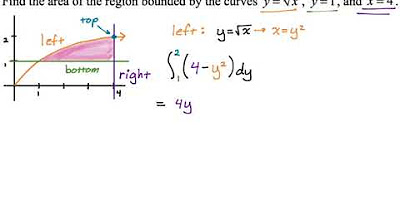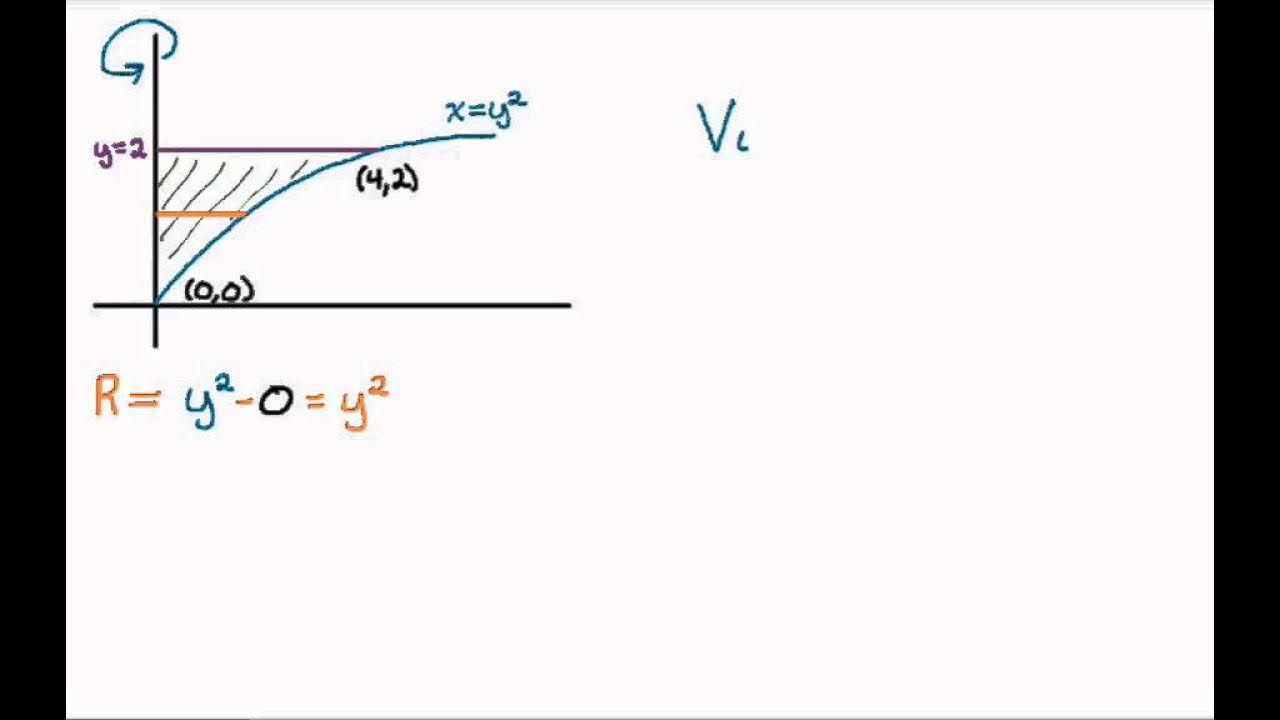Double Integration Example over General Regions --- two ways!
TLDRThis video tutorial explores the process of calculating the volume under a surface when the domain is not a standard rectangle but a region bounded by the curve y = sqrt(x), the line x = 1, and the x-axis. The presenter demonstrates two methods: vertical and horizontal slicing, integrating the area of each slice with respect to x and y. The example involves the function 1 + x + y^2, and the video concludes with the same result obtained using both methods, emphasizing the consistency of mathematical approaches.
Takeaways
- 📚 The video discusses calculating the volume under a surface when the region of interest is not a standard rectangle but a more complex shape.
- 🔍 The domain has three sides: the x-axis, the line x equals one, and the curve y equals the square root of x.
- 📈 The strategy involves slicing the volume into thin vertical strips and integrating the areas of these slices with respect to x from 0 to 1.
- 📐 The function given is 1 plus X plus y squared, which is bounded by the x-axis, the line x equals 1, and the curve y equals the square root of x.
- 📉 The volume is calculated by integrating the area 'a of X' with respect to x, where 'a of X' is the area under the curve at a specific x value.
- 🧩 The inner integral is with respect to y, with limits from 0 to the square root of x, reflecting that the limits of integration can be functions of the variable.
- 📝 The inner integral evaluates to an expression involving powers of x, which is then integrated with respect to x over the interval [0, 1].
- 🔢 The resulting integral simplifies to an expression involving powers of x, which is then evaluated at the endpoints of the interval to find the volume.
- 🔄 An alternative approach is presented using horizontal strips, integrating with respect to y first and then x, yielding the same volume.
- 📐 The limits for the horizontal strip method are from y equals 0 to 1, with the left endpoint for x being y squared and the right endpoint being 1.
- 📊 The final volume calculation for both methods results in the same answer, demonstrating the consistency of the approach regardless of the method used.
Q & A
What is the main topic of the video?
-The main topic of the video is finding the volume underneath a particular surface when the domain is not a standard rectangular region.
What is the shape of the region being considered in the video?
-The region being considered is not a rectangle but has a curve defined by the equation y = sqrt(x), with the x-axis, the line x = 1, and the curve as its boundaries.
What strategy is used to find the volume under the surface?
-The strategy used is to compute the volume by integrating the areas of all the little slices as the x value goes from 0 to 1.
What function is used to represent the surface in the video?
-The function representing the surface is 1 + x + y^2.
How does the video approach the integration of the volume?
-The video uses a double integral approach, first integrating with respect to y and then with respect to x.
What are the limits of integration for the inner integral with respect to y?
-The limits of integration for the inner integral with respect to y are from 0 to sqrt(x).
How does the video handle the limits of integration that are functions?
-The video evaluates the integral by substituting the function for the limits, such as using sqrt(x) as the upper limit for the y integration.
What is the result of the volume calculation in the video?
-The result of the volume calculation is 18/15 or 6/5, which is obtained by evaluating the double integral.
Is there an alternative approach shown in the video to find the volume?
-Yes, the video also shows an alternative approach using horizontal strips and integrating with respect to x first and then y.
How does the video ensure the consistency of the results between the two approaches?
-The video ensures consistency by showing that both the vertical and horizontal strip methods yield the same result for the volume.
What does the video suggest for further learning?
-The video suggests checking out a larger playlist on multivariable calculus for more learning on the topic.
Outlines
📚 Calculating Volume Under a Surface with Irregular Domain
This paragraph introduces the concept of finding the volume under a surface when the domain is not a standard rectangle but an irregular region defined by the curve y = sqrt(x), the line x = 1, and the x-axis. The strategy involves slicing the volume into thin vertical strips and integrating the areas of these slices from x = 0 to x = 1. The function described is 1 + x + y^2, and the area under the curve at a specific x is found by integrating with respect to y from 0 to sqrt(x). The limits of integration are not constant but depend on the function, leading to an integral within an integral, where the inner integral is with respect to y, and the outer is with respect to x.
🔍 Detailed Integration Process for Volume Calculation
The second paragraph delves into the detailed process of calculating the volume under the surface using the method of integration. It explains how to compute the area of a slice at a specific x-value and then integrate these areas over the interval from 0 to 1. The paragraph walks through the integration steps, including evaluating the function at the limits of integration and simplifying the resulting expression. The integration with respect to y yields an expression involving powers of x, which is then integrated with respect to x to find the volume. The final result is simplified to a numerical value, demonstrating that the approach is consistent with the principles of calculus.
📈 Alternative Approach Using Horizontal Strips
The final paragraph presents an alternative method for calculating the volume by using horizontal strips instead of vertical ones. It discusses the process of integrating with respect to y first and then x, with the limits of integration for x being determined by the curve y = sqrt(x) and the line x = 1. The paragraph explains how to find the left endpoint for the x-integration by setting y^2 = x and solving for x. The integration process is carried out, and the resulting expression is simplified to find the volume, which confirms the consistency of the result with the vertical strip method. The paragraph concludes with an invitation for viewers to engage with the content by asking questions and exploring more videos on the topic.
Mindmap
Keywords
💡Volume
💡Domain
💡Surface
💡Slices
💡Integration
💡Curve
💡Limits of Integration
💡Double Integral
💡Horizontal Strips
💡Vertical Strips
💡Endpoints
Highlights
The video discusses finding the volume under a surface when the domain is not a standard rectangular region.
The domain is defined by the curve y = √x, the line x = 1, and the x-axis.
Volume under a surface is calculated by integrating the area of slices across the domain.
An example slice is computed at x = 0.2 to illustrate the process.
The strategy involves integrating the area function a(x) with respect to x from 0 to 1.
The function for the surface is given as 1 + x + y^2, bounded by the specified domain.
The area function a(x) is an integral with respect to y, with limits from 0 to √x.
Integration limits can be functions of the variable of integration, not just constants.
The integral is computed by first integrating with respect to y, then x.
The result of the inner integral is a function of x, which is then integrated with respect to x.
The final volume calculation is simplified to an integral of a function of x from 0 to 1.
An alternative method using horizontal strips is introduced for a different perspective.
Horizontal strips integrate with respect to x first, then y, offering a varied approach.
The limits of integration for the horizontal strips are y^2 and 1.
The double integral for horizontal strips is computed, yielding the same volume.
The video concludes by demonstrating that both vertical and horizontal strip methods yield identical results.
The video encourages engagement by asking viewers to leave comments and like the video.
A playlist of multivariable calculus videos is mentioned for further learning.
Transcripts
Browse More Related Video

Volume of Revolution Examples - Horizontal Axis

Area Between Curves: Integrating with Respect to y (Example 3)

Volume of Revolution Examples - Vertical Axis

Lecture 20: Several Variables Volumes Galore

Finding a Horizontal Line (y=k) to Divide a Region into Two Equal Parts Using Calculus

Fundamental Theorem of Calculus Explained | Outlier.org
5.0 / 5 (0 votes)
Thanks for rating: